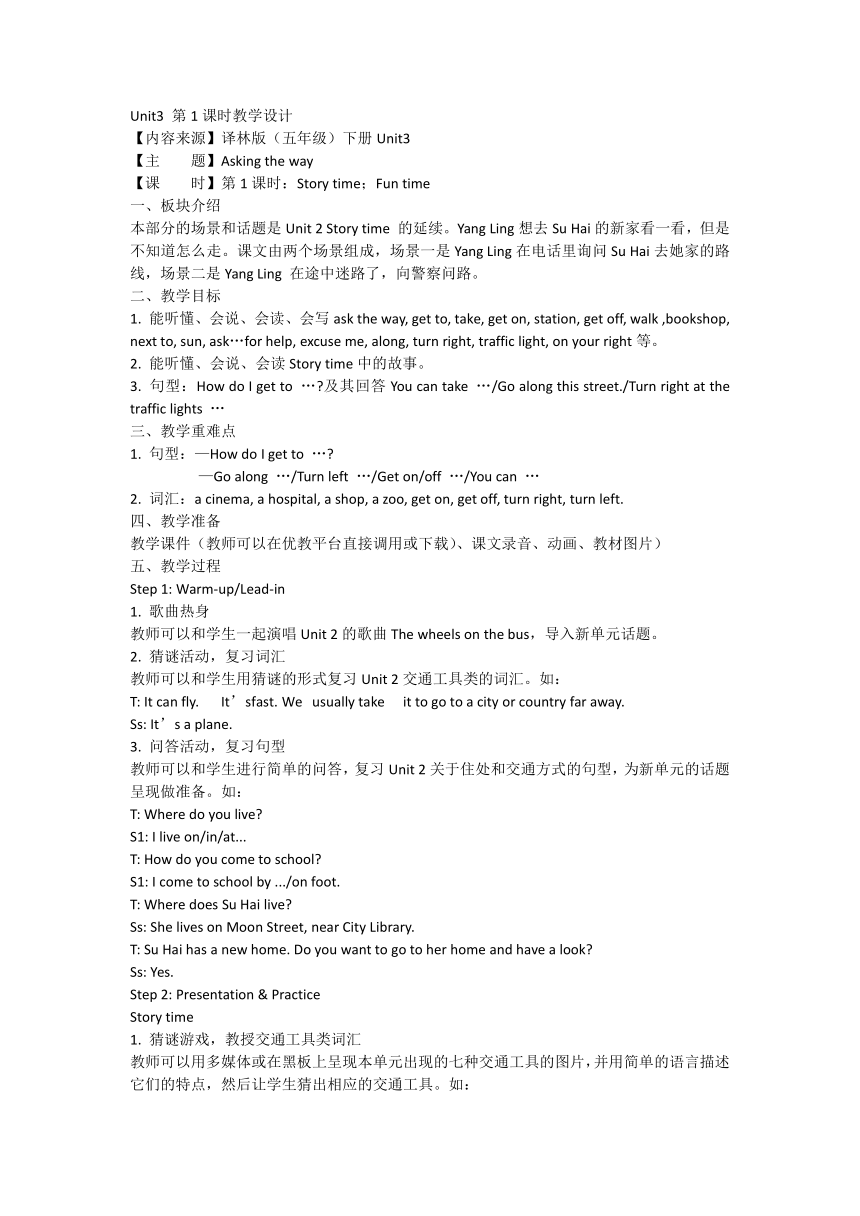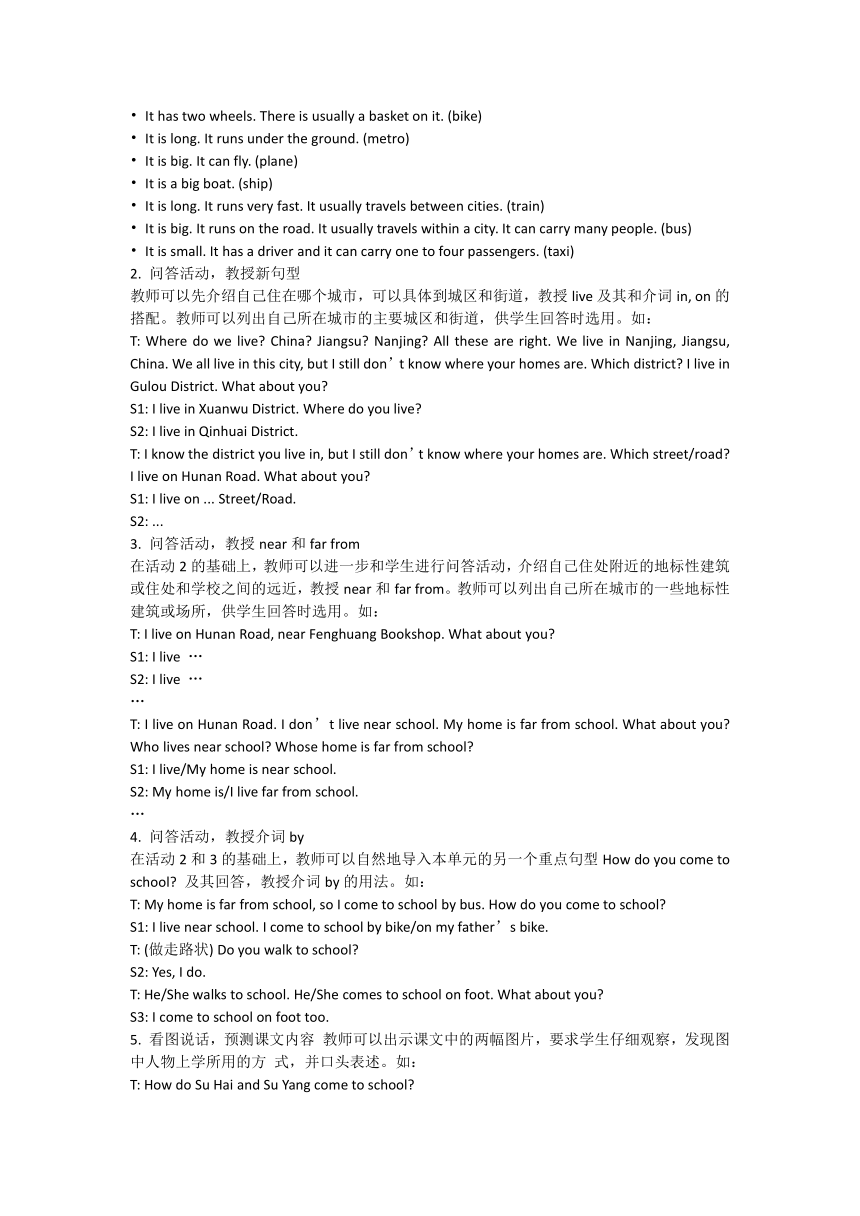Unit3 Asking the way第1课时教学设计
文档属性
| 名称 | Unit3 Asking the way第1课时教学设计 |  | |
| 格式 | docx | ||
| 文件大小 | 14.9KB | ||
| 资源类型 | 教案 | ||
| 版本资源 | 牛津译林版 | ||
| 科目 | 英语 | ||
| 更新时间 | 2023-06-09 21:51:38 | ||
图片预览


文档简介
Unit3 第1课时教学设计
【内容来源】译林版(五年级)下册Unit3
【主 题】Asking the way
【课 时】第1课时:Story time;Fun time
一、板块介绍
本部分的场景和话题是Unit 2 Story time 的延续。Yang Ling想去Su Hai的新家看一看,但是不知道怎么走。课文由两个场景组成,场景一是Yang Ling在电话里询问Su Hai去她家的路线,场景二是Yang Ling 在途中迷路了,向警察问路。
二、教学目标
1. 能听懂、会说、会读、会写ask the way, get to, take, get on, station, get off, walk ,bookshop, next to, sun, ask…for help, excuse me, along, turn right, traffic light, on your right等。
2. 能听懂、会说、会读Story time中的故事。
3. 句型:How do I get to … 及其回答You can take …/Go along this street./Turn right at the traffic lights …
三、教学重难点
1. 句型:—How do I get to …
—Go along …/Turn left …/Get on/off …/You can …
2. 词汇:a cinema, a hospital, a shop, a zoo, get on, get off, turn right, turn left.
四、教学准备
教学课件(教师可以在优教平台直接调用或下载)、课文录音、动画、教材图片)
五、教学过程
Step 1: Warm-up/Lead-in
1. 歌曲热身
教师可以和学生一起演唱Unit 2的歌曲The wheels on the bus,导入新单元话题。
2. 猜谜活动,复习词汇
教师可以和学生用猜谜的形式复习Unit 2交通工具类的词汇。如:
T: It can fly. It’s fast. We usually take it to go to a city or country far away.
Ss: It’s a plane.
3. 问答活动,复习句型
教师可以和学生进行简单的问答,复习Unit 2关于住处和交通方式的句型,为新单元的话题呈现做准备。如:
T: Where do you live
S1: I live on/in/at...
T: How do you come to school
S1: I come to school by .../on foot.
T: Where does Su Hai live
Ss: She lives on Moon Street, near City Library.
T: Su Hai has a new home. Do you want to go to her home and have a look
Ss: Yes.
Step 2: Presentation & Practice
Story time
1. 猜谜游戏,教授交通工具类词汇
教师可以用多媒体或在黑板上呈现本单元出现的七种交通工具的图片,并用简单的语言描述它们的特点,然后让学生猜出相应的交通工具。如:
It has two wheels. There is usually a basket on it. (bike)
It is long. It runs under the ground. (metro)
It is big. It can fly. (plane)
It is a big boat. (ship)
It is long. It runs very fast. It usually travels between cities. (train)
It is big. It runs on the road. It usually travels within a city. It can carry many people. (bus)
It is small. It has a driver and it can carry one to four passengers. (taxi)
2. 问答活动,教授新句型
教师可以先介绍自己住在哪个城市,可以具体到城区和街道,教授live及其和介词in, on的搭配。教师可以列出自己所在城市的主要城区和街道,供学生回答时选用。如:
T: Where do we live China Jiangsu Nanjing All these are right. We live in Nanjing, Jiangsu, China. We all live in this city, but I still don’t know where your homes are. Which district I live in Gulou District. What about you
S1: I live in Xuanwu District. Where do you live
S2: I live in Qinhuai District.
T: I know the district you live in, but I still don’t know where your homes are. Which street/road I live on Hunan Road. What about you
S1: I live on ... Street/Road.
S2: ...
3. 问答活动,教授near和far from
在活动2的基础上,教师可以进一步和学生进行问答活动,介绍自己住处附近的地标性建筑或住处和学校之间的远近,教授near和far from。教师可以列出自己所在城市的一些地标性建筑或场所,供学生回答时选用。如:
T: I live on Hunan Road, near Fenghuang Bookshop. What about you
S1: I live …
S2: I live …
…
T: I live on Hunan Road. I don’t live near school. My home is far from school. What about you Who lives near school Whose home is far from school
S1: I live/My home is near school.
S2: My home is/I live far from school.
…
4. 问答活动,教授介词by
在活动2和3的基础上,教师可以自然地导入本单元的另一个重点句型How do you come to school 及其回答,教授介词by的用法。如:
T: My home is far from school, so I come to school by bus. How do you come to school
S1: I live near school. I come to school by bike/on my father’s bike.
T: (做走路状) Do you walk to school
S2: Yes, I do.
T: He/She walks to school. He/She comes to school on foot. What about you
S3: I come to school on foot too.
5. 看图说话,预测课文内容 教师可以出示课文中的两幅图片,要求学生仔细观察,发现图中人物上学所用的方 式,并口头表述。如:
T: How do Su Hai and Su Yang come to school
Ss: They come to school by bus.
T: How does Yang Ling come to school
Ss: She comes to school on foot.
T: How does Mike come to school
Ss: He comes to school by metro.
T: How does Liu Tao come to school
Ss: He comes to school by taxi.
6. 听录音,理解课文大意 教师播放课文录音,要求学生在图片的帮助下理解对话大意,然后完成学生用书第18页的Read and circle。
7. 贴一贴,说一说
教师可以在课前准备一幅和课文对话内容相关的地图,标出School, Moon Street, City Library, Sunshine Town, Park Street等几个地标,并用表示道路的线将学校和其他各处连接,同时准备课文中出现的四个人物图片及他们所用的交通方式图片。教师安排学生独立阅读对话后,要求他们将人物图片和交通方式图片贴到地图的相应位置上,然后再口头描述,以检测学生获取课文细节信息的能力。如:
S1: Su Hai’s home is far from school. She lives on Moon Street, near City Library. She comes to school by bus.
S2: Yang Ling lives near school. She comes to school on foot.
…
8. 角色扮演,复述课文
教师可以要求学生扮演其中一个人物,先介绍自己的情况,再介绍其他三位人物的情况。这个活动可以让学生巩固一般现在时的语法知识,同时也可以培养学生归纳复述课文的能力。如:
Ss: I’m Yang Ling. I live near school. I come to school on foot. Su Hai’s new home is very big, but it’s far from school. It’s on Moon Street. She has to come to school by bus. Mike lives in Sunshine Town. He comes to school by metro. Liu Tao lives on Park Street. He comes to school by taxi because his father is a taxi driver.
Fun time
一、板块介绍
本板块是一个问答活动,要求学生两人一组,一人选择地图中的地点问路,另一人根据地图上的起点,给出合适的路线。通过这一活动,学生可以继续操练有关问路的句型How do I get to the … 以及指路的用语go along ... turn left/ right at ...和on your left/right等。教师可以让学生找出到达同一地点的不同路线,灵活操练。
二、教学活动
1. 语言准备
教师先要求学生认读地图上的路名和地点,学会看地图,并确定地图中自己所在的位置。如:
T: Where are you
S1: I’m on Mango Street.
T: Where’s the cinema
S2: It’s on Orange Street.
…
2. 小组问答活动
教师安排学生两人一组,进行问路和指路的问答活动,然后交换角色。同一目的 地,可以有不同的到达路线,教师可以鼓励学生尝试给出不同的路线。
3. 师生问答
教师以问路人的身份,向学生提问,检测学生的操练情况。
4. 听听猜猜
教师描述路线,让学生边听边看地图,寻找目的地。如:
T: I’m now on Grape Street. I go along Grape Street and turn right at the traffic lights. Then, I’m on Orange Street. It’s on my left. Where do I get
S1: The cinema.
Step 3: Consolidation
1. 听录音,跟读课文
教师播放课文录音,让学生跟读对话,模仿语音语调。
2. 图文匹配
教师安排学生完成学生用书第28页的Read and match,将句子和图片匹配。教师也可以将本活动作为句子排序活动,以呈现Yang Ling去Su Hai家的过程。
3. 看图指路,复述课文
教师可以安排学生三人一组,根据已经画好的路线图,或利用学生用书第28页 Look and say的线路图,分角色问路和指路,以巩固课文内容。教师也可以邀请若干学生介绍Yang Ling是如何来到Su Hai家的,完成Look and say的口头表达任务。
Step 4: Summary
师生一起总结本课所学的词汇和句型,鼓励学生提出问题。教师点评学生的表现。
Read and match
参考答案
1. e 2. d 3. a 4. b 5. c
Look and say
参考答案
First, Yang Ling gets on the metro at Park Station. Next, she gets off the metro at City Library Station. Then, she’s on Sun Street. She walks along Sun Street and turns right at the traffic lights. Finally, she’s on Moon Street. She can see the bookshop on her right. Su Hai’s home is next to the bookshop.
【内容来源】译林版(五年级)下册Unit3
【主 题】Asking the way
【课 时】第1课时:Story time;Fun time
一、板块介绍
本部分的场景和话题是Unit 2 Story time 的延续。Yang Ling想去Su Hai的新家看一看,但是不知道怎么走。课文由两个场景组成,场景一是Yang Ling在电话里询问Su Hai去她家的路线,场景二是Yang Ling 在途中迷路了,向警察问路。
二、教学目标
1. 能听懂、会说、会读、会写ask the way, get to, take, get on, station, get off, walk ,bookshop, next to, sun, ask…for help, excuse me, along, turn right, traffic light, on your right等。
2. 能听懂、会说、会读Story time中的故事。
3. 句型:How do I get to … 及其回答You can take …/Go along this street./Turn right at the traffic lights …
三、教学重难点
1. 句型:—How do I get to …
—Go along …/Turn left …/Get on/off …/You can …
2. 词汇:a cinema, a hospital, a shop, a zoo, get on, get off, turn right, turn left.
四、教学准备
教学课件(教师可以在优教平台直接调用或下载)、课文录音、动画、教材图片)
五、教学过程
Step 1: Warm-up/Lead-in
1. 歌曲热身
教师可以和学生一起演唱Unit 2的歌曲The wheels on the bus,导入新单元话题。
2. 猜谜活动,复习词汇
教师可以和学生用猜谜的形式复习Unit 2交通工具类的词汇。如:
T: It can fly. It’s fast. We usually take it to go to a city or country far away.
Ss: It’s a plane.
3. 问答活动,复习句型
教师可以和学生进行简单的问答,复习Unit 2关于住处和交通方式的句型,为新单元的话题呈现做准备。如:
T: Where do you live
S1: I live on/in/at...
T: How do you come to school
S1: I come to school by .../on foot.
T: Where does Su Hai live
Ss: She lives on Moon Street, near City Library.
T: Su Hai has a new home. Do you want to go to her home and have a look
Ss: Yes.
Step 2: Presentation & Practice
Story time
1. 猜谜游戏,教授交通工具类词汇
教师可以用多媒体或在黑板上呈现本单元出现的七种交通工具的图片,并用简单的语言描述它们的特点,然后让学生猜出相应的交通工具。如:
It has two wheels. There is usually a basket on it. (bike)
It is long. It runs under the ground. (metro)
It is big. It can fly. (plane)
It is a big boat. (ship)
It is long. It runs very fast. It usually travels between cities. (train)
It is big. It runs on the road. It usually travels within a city. It can carry many people. (bus)
It is small. It has a driver and it can carry one to four passengers. (taxi)
2. 问答活动,教授新句型
教师可以先介绍自己住在哪个城市,可以具体到城区和街道,教授live及其和介词in, on的搭配。教师可以列出自己所在城市的主要城区和街道,供学生回答时选用。如:
T: Where do we live China Jiangsu Nanjing All these are right. We live in Nanjing, Jiangsu, China. We all live in this city, but I still don’t know where your homes are. Which district I live in Gulou District. What about you
S1: I live in Xuanwu District. Where do you live
S2: I live in Qinhuai District.
T: I know the district you live in, but I still don’t know where your homes are. Which street/road I live on Hunan Road. What about you
S1: I live on ... Street/Road.
S2: ...
3. 问答活动,教授near和far from
在活动2的基础上,教师可以进一步和学生进行问答活动,介绍自己住处附近的地标性建筑或住处和学校之间的远近,教授near和far from。教师可以列出自己所在城市的一些地标性建筑或场所,供学生回答时选用。如:
T: I live on Hunan Road, near Fenghuang Bookshop. What about you
S1: I live …
S2: I live …
…
T: I live on Hunan Road. I don’t live near school. My home is far from school. What about you Who lives near school Whose home is far from school
S1: I live/My home is near school.
S2: My home is/I live far from school.
…
4. 问答活动,教授介词by
在活动2和3的基础上,教师可以自然地导入本单元的另一个重点句型How do you come to school 及其回答,教授介词by的用法。如:
T: My home is far from school, so I come to school by bus. How do you come to school
S1: I live near school. I come to school by bike/on my father’s bike.
T: (做走路状) Do you walk to school
S2: Yes, I do.
T: He/She walks to school. He/She comes to school on foot. What about you
S3: I come to school on foot too.
5. 看图说话,预测课文内容 教师可以出示课文中的两幅图片,要求学生仔细观察,发现图中人物上学所用的方 式,并口头表述。如:
T: How do Su Hai and Su Yang come to school
Ss: They come to school by bus.
T: How does Yang Ling come to school
Ss: She comes to school on foot.
T: How does Mike come to school
Ss: He comes to school by metro.
T: How does Liu Tao come to school
Ss: He comes to school by taxi.
6. 听录音,理解课文大意 教师播放课文录音,要求学生在图片的帮助下理解对话大意,然后完成学生用书第18页的Read and circle。
7. 贴一贴,说一说
教师可以在课前准备一幅和课文对话内容相关的地图,标出School, Moon Street, City Library, Sunshine Town, Park Street等几个地标,并用表示道路的线将学校和其他各处连接,同时准备课文中出现的四个人物图片及他们所用的交通方式图片。教师安排学生独立阅读对话后,要求他们将人物图片和交通方式图片贴到地图的相应位置上,然后再口头描述,以检测学生获取课文细节信息的能力。如:
S1: Su Hai’s home is far from school. She lives on Moon Street, near City Library. She comes to school by bus.
S2: Yang Ling lives near school. She comes to school on foot.
…
8. 角色扮演,复述课文
教师可以要求学生扮演其中一个人物,先介绍自己的情况,再介绍其他三位人物的情况。这个活动可以让学生巩固一般现在时的语法知识,同时也可以培养学生归纳复述课文的能力。如:
Ss: I’m Yang Ling. I live near school. I come to school on foot. Su Hai’s new home is very big, but it’s far from school. It’s on Moon Street. She has to come to school by bus. Mike lives in Sunshine Town. He comes to school by metro. Liu Tao lives on Park Street. He comes to school by taxi because his father is a taxi driver.
Fun time
一、板块介绍
本板块是一个问答活动,要求学生两人一组,一人选择地图中的地点问路,另一人根据地图上的起点,给出合适的路线。通过这一活动,学生可以继续操练有关问路的句型How do I get to the … 以及指路的用语go along ... turn left/ right at ...和on your left/right等。教师可以让学生找出到达同一地点的不同路线,灵活操练。
二、教学活动
1. 语言准备
教师先要求学生认读地图上的路名和地点,学会看地图,并确定地图中自己所在的位置。如:
T: Where are you
S1: I’m on Mango Street.
T: Where’s the cinema
S2: It’s on Orange Street.
…
2. 小组问答活动
教师安排学生两人一组,进行问路和指路的问答活动,然后交换角色。同一目的 地,可以有不同的到达路线,教师可以鼓励学生尝试给出不同的路线。
3. 师生问答
教师以问路人的身份,向学生提问,检测学生的操练情况。
4. 听听猜猜
教师描述路线,让学生边听边看地图,寻找目的地。如:
T: I’m now on Grape Street. I go along Grape Street and turn right at the traffic lights. Then, I’m on Orange Street. It’s on my left. Where do I get
S1: The cinema.
Step 3: Consolidation
1. 听录音,跟读课文
教师播放课文录音,让学生跟读对话,模仿语音语调。
2. 图文匹配
教师安排学生完成学生用书第28页的Read and match,将句子和图片匹配。教师也可以将本活动作为句子排序活动,以呈现Yang Ling去Su Hai家的过程。
3. 看图指路,复述课文
教师可以安排学生三人一组,根据已经画好的路线图,或利用学生用书第28页 Look and say的线路图,分角色问路和指路,以巩固课文内容。教师也可以邀请若干学生介绍Yang Ling是如何来到Su Hai家的,完成Look and say的口头表达任务。
Step 4: Summary
师生一起总结本课所学的词汇和句型,鼓励学生提出问题。教师点评学生的表现。
Read and match
参考答案
1. e 2. d 3. a 4. b 5. c
Look and say
参考答案
First, Yang Ling gets on the metro at Park Station. Next, she gets off the metro at City Library Station. Then, she’s on Sun Street. She walks along Sun Street and turns right at the traffic lights. Finally, she’s on Moon Street. She can see the bookshop on her right. Su Hai’s home is next to the bookshop.
